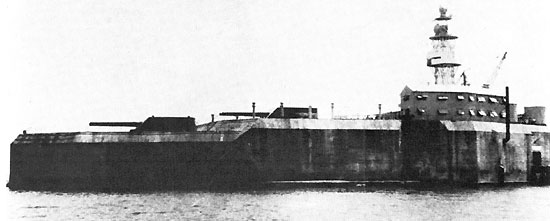Corregidor: Epic of 'Grim, Gaunt & Ghastly Men'
The War Illustrated, Volume 5, No. 129, Page 731, May 29, 1942.
After five months of heroic struggle against overwhelmingly superior numbers, Lieut.-Gen. J. M. Wainwright, commander of the American forces on Corregidor Island, was forced to surrender to the Japanese. The news was issued from Gen. MacArthur's headquarters in Australia early in the morning of May 6.
Paying a fine tribute to the men with whom he had lately served, the General said: "Corregidor needs no comment from me. It has sounded its own story at the mouth of its guns. It has enscrolled its own epitaph on the enemy tablets. But through the bloody haze of its last reverberating shot I shall always seem to see the vision of grim, gaunt, ghastly men – still unafraid."
 Fort Drum, an unsinkable "battleship" of concrete built on top of El Fraile Island in the mouth of Manila Bay. Here heavily-armoured turrets mounted 16-inch guns which wrought great havoc on the Japanese troops trying to enter the bay. Photo, Keystone.
Fort Drum, an unsinkable "battleship" of concrete built on top of El Fraile Island in the mouth of Manila Bay. Here heavily-armoured turrets mounted 16-inch guns which wrought great havoc on the Japanese troops trying to enter the bay. Photo, Keystone.
Se fell, for the time being, the Allies' last stronghold in the Western Pacific, together with three other forts in Manila Bay, Hughes, Drum and Frank, and the finest harbour in the Pacific.
Towards the end of this epic fight Corregidor was subjected to 13 separate air attacks each day for four days, and was bombarded by many 240-millimetre guns firing from new positions captured by the Japanese. In the final assault the enemy made use of a large number of steel barges in the two-mile trip from the tip of Bataan Peninsula to the island fortress.
A Domei Agency dispatch from a Japanese base in the Philippines gave a description of the last hours before the fort capitulated. "Under cover of darkness and an intensive rolling artillery barrage. Japanese expeditionary forces, which had been biding their time since the complete occupation of the Bataan Peninsula, swarmed across the narrow channel separating Corregidor in an all-out offensive to crush Gen. Jonathan Wainwright's beleaguered Filipino and American forces. The invasion of the American stronghold was carried out by boats heavily laden with Japanese shock troops, which passed through the mine-studded waters round Corregidor Island. The initial landing was effected at 11 p.m., when a three-column Japanese invasion party crossed over to Corregidor in the face of terrific American fire, with a second and a third landing party following in their wake in rapid succession."
Then followed a vivid account of terrible hand-to-hand fighting with bayonets and sabres, with bombers pulverizing the American fortifications to open points for the Japanese advance. In the same way the other American forts in Manila Bay were captured, the Japanese announcing that all positions were in their hands by May 6.
Immediately before the fall of Corregidor Lieut.-Gen. Wainwright issued the following message:
"I've been with my men from the start, and if captured I will share their lot. We've been through so much together that my conscience would not let me leave before the final curtain. Americans shaken by the loss of Bataan should not feel the fall of the Manila Bay forts is a double tragedy, but rather an exemplification of the grimness of our spirit when we stay to the end with the job to be done."
Far from disheartening the American public, the loss of the Philippines fight, of which Corregidor was the final episode, came as a new inspiration. In view of the fact that it took the Japanese five months to accomplish what they had hoped to do in twice as many days, America might well claim a moral victory.
On reports received up till April 15, the U.S. War Department estimated that, including naval personnel, marines, soldiers, Philippine scouts, soldiers of the Philippine Commonwealth Army and various civilians, there were 11,574 persons in the Manila Bay area. With the exception of casualties since that date, they may be presumed to have been taken prisoner.
In the name of the President, the War Department published general orders citing, not individuals, but 30 separate units of the American and Philippine soldiers for their heroism.
In an Australian tribute Mr. Curtin, the Prime Minister, said: "Corregidor takes its place in world history. We had our Tobruk, America has its Corregidor. Standing to that spirit of dauntless gallantry we cannot lose."
Index
Previous article
Chiefs of the United Nations in Chungking
Our ultimate victory against the brutality and aggression of the Axis Powers is beyond doubt. You have on your side four of the toughest and most enduring races of the world – the British, Chinese,
Next article
Has Prinz Eugen Lived to Fight Another Day?
Prinz Eugen, the German light cruiser, would appear, like Hitler, to have the most diabolical luck. After the R.A.F. torpedo and bomb attack on May 17 near Trondheim, she escaped to Kiel, but judging



